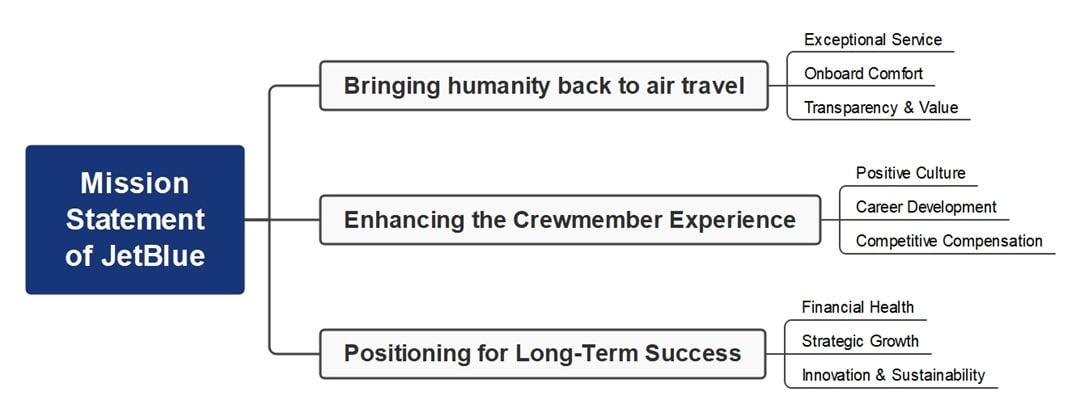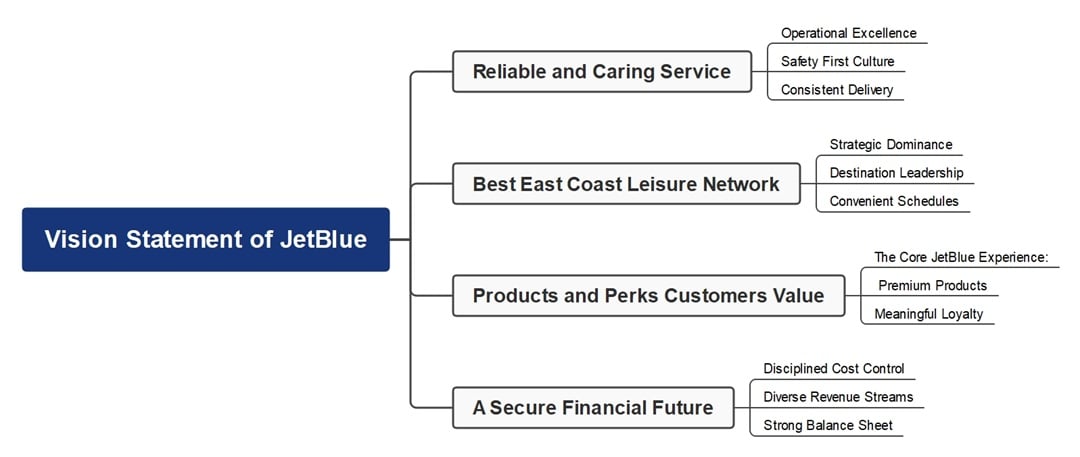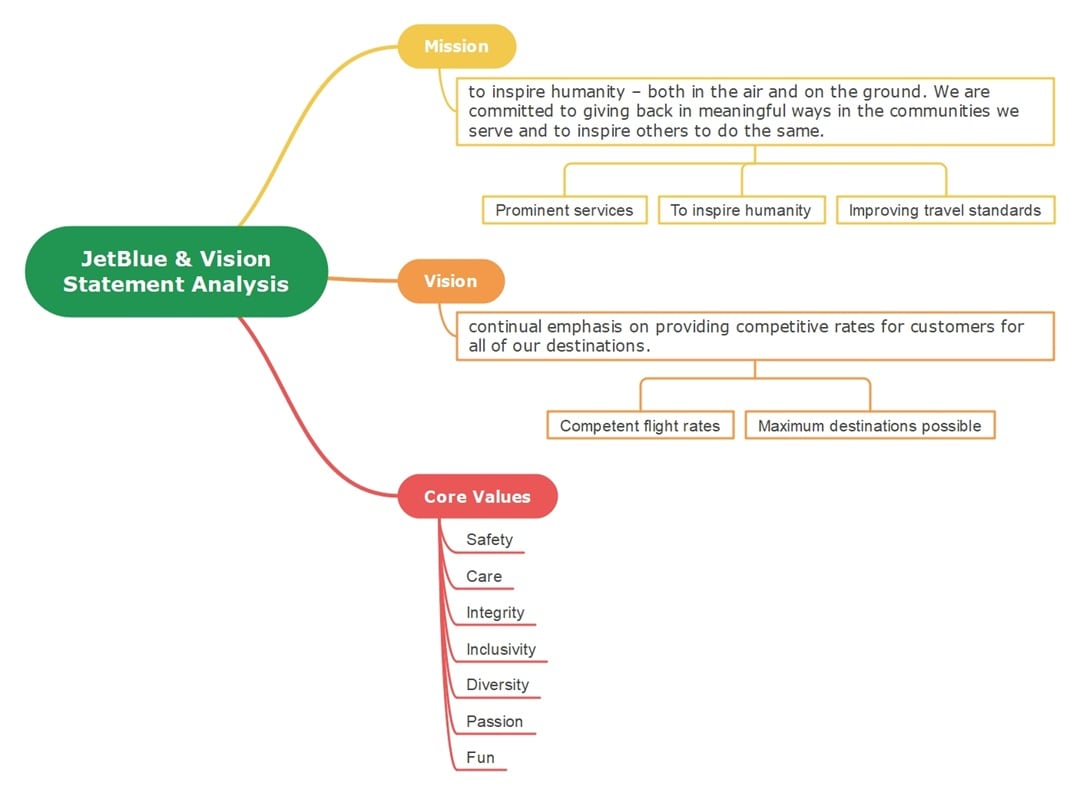An interesting and insightful analysis of the mission and vision of JetBlue gives us a clear picture of how the company distinguishes itself from others.
JetBlue has become a household name as a low-cost carrier that offers low fares, keeps to its schedules, and has a customer-friendly approach.
It is quite a distinction from merely selling tickets. It is about earning your trust every time you travel.
If you want the meaning behind JetBlue’s mission and vision, then scroll down. Here, you will see how the airline defines its purpose, sets goals, and creates a travel experience that millions still choose today.
In this article
Overview of JetBlue
JetBlue started in February 2000 with a big promise: to re-establish the “human factor” in air transport. More than 20 years later, that promise remains the primary guiding principle for the airline’s decisions. The point is simple.
You get more than a seat on a plane. You get an experience built around comfort and care.
JetBlue has, basically, spread its wings over the whole world. The company made a big decision for its fleet, started flying to Europe, and for those who want a premium trip, it introduced Mint.
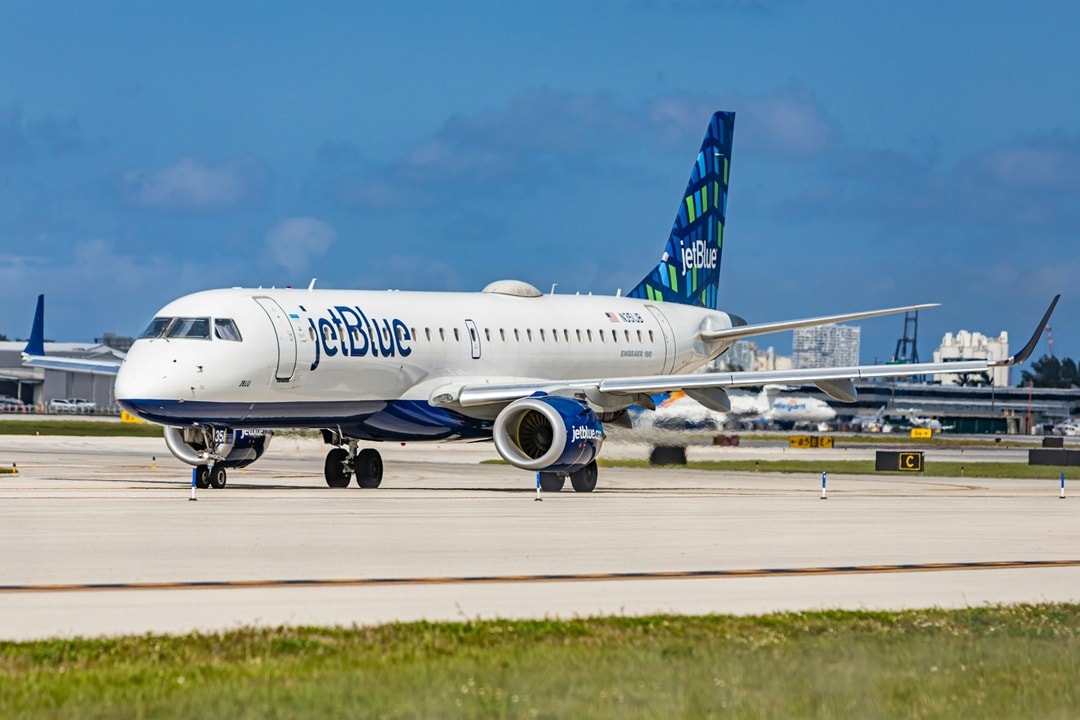
Meanwhile, it did not forget to keep the little things that passengers love. Free high-speed Wi-Fi, live TV, movies, and complimentary snacks are all part of the service.
JetBlue now connects millions of travelers to over 100 destinations. None of it works without its 23,000 crewmembers. They are the people who turn the mission into a reality every single day.
Here are some highlights that show where JetBlue stands today:
| Aspect | Information |
| Founded | February 2000 |
| Headquarters | Long Island City, New York, USA |
| CEO | Joanna Geraghty |
| Crewmembers | 23,000 crewmembers |
| Destinations | 100+ across the U.S., Latin America, Caribbean, Canada, and Europe |
| Earnings Before Interest and Taxes | $90 million incremental EBIT (first half of 2025) |
| Operating Revenue | $2.4 billion (2nd quarter of 2025) |
Mission Statement of JetBlue
JetBlue calls itself New York’s Hometown Airline. Its mission is all about “bringing humanity back to air travel.”
JetBlue would be going out of its way to present to you not simply a more affordable ticket but an even better travel experience. The airline aims to provide you with a trip that is more personal, dependable, and enjoyable.
But their mission’s focus is not only on passengers. It is also on the people who work behind the scenes. When crewmembers feel valued, they serve you better.
The big idea is balance. Care for the crew, care for the customer, and build a company that lasts.
Below is JetBlue’s mission statement analysis.
Bringing Humanity Back
So how does JetBlue put this into practice? It offers extras that used to feel impossible on a budget airline. Free Wi-Fi, live TV, drinks, and snacks are all part of the package.
The point is clear. You don’t need to sacrifice comfort for a lower price. Add to that a culture of friendly and helpful service, and you see why “humanity” is more than just a word in a mission statement.
Enhancing the Crewmember Experience
JetBlue also knows that service starts with the people who wear the uniform. The airline works to create a workplace where crewmembers feel they belong.
In turn, that sense of belonging shows up in the way they treat you on board.
It is an instant relationship. The better the staff morale, the safer the environment, the fewer delays will occur, and the customer care will be of a higher quality.
Positioning for Long-Term Success
The mission goes beyond today’s flights. JetBlue invests in programs that support both employees and customers.
The result is loyalty. Happy passengers come back. Engaged crewmembers stay longer.
That combination builds strength for the future. In other words, JetBlue’s focus on people is also a smart business strategy. It creates a cycle of trust, service, and growth that positions the airline for lasting success.
Vision Statement of JetBlue
JetBlue doesn’t post a classic “vision statement” on its website. Instead, it shares JetForward, a multi-year roadmap built on a simple idea: Be Loved. Be Profitable.
This phrase captures the airline’s direction. It shows a balance between caring for people and securing financial growth. The plan is not vague. It is broken down into strategic moves that guide how JetBlue operates, competes, and invests.
Here's the JetBlue’s vision statement analysis.
Reliable and Caring Service
The first move is reliability. JetBlue knows customers want flights that arrive on time. That is why it invests in operations that cut delays and improve consistency.
The aim is simple. A reliable service builds trust, and trust leads to loyalty. By focusing on both care and punctuality, JetBlue strengthens the customer experience.
Best East Coast Leisure Network
The second move is about routes. JetBlue leans into the East Coast, where demand is strong and its brand already resonates. This way, it optimizes resources instead of stretching too thin.
For example, it redeployed flights from underperforming routes to leisure and family travel markets. It also expanded in Puerto Rico and added new Mint cities. By focusing on proven markets, JetBlue keeps its network profitable and competitive.
Products and Perks Customers Value
The third move is about extras. JetBlue continues to enhance products that passengers actually care about. It added preferred seating, new loyalty partners, and a premium credit card.
It also improved Blue Basic with a free carry-on bag. The message is obvious. Customers get value for their money, and loyalty grows in return.
A Secure Financial Future
The final move ties everything together. JetBlue commits to financial discipline. It updated aircraft deliveries, raised more than $3 billion in financing, and reduced costs with organizational changes.
The outcome is stability. Strong finances allow JetBlue to reinvest in service, routes, and perks.
In short, JetForward is more than a roadmap. It is a strategy that blends customer care, growth, and financial strength into one vision for the future.
Core Values of JetBlue
JetBlue highlights five core values that shape everything it does: Safety, Caring, Integrity, Passion, and Fun.
They are not just portrayed there. They show how the airline both passenger-wise and crewmember-wise treats and also how it uses these same values to build its brand.
The best part is that you can actually see these core values in action.
Safety
Safety comes first. For JetBlue, it’s not only about preventing accidents. It’s about creating a workplace where crewmembers feel supported. The starting point of this cycle should be prominent.
When the staff feels secure and respected, they not only run safer operations but also provide better service. That feeling of confidence directly leads to smoother interactions when you board your plane.
Caring
Care is the value that, apart from customers, also includes JetBlue employees. Small and seemingly insignificant details that mean a lot make the airline different and give the brand much more loyal customers.
In fact, free snacks, Wi-Fi, and TV are the ways to prove that comfort matters at every price point. Similarly, JetBlue provides its employees with the same level of love through programs that nurture belonging and development.
Integrity
JetBlue applies this by being transparent with pricing and policies. You know what to expect before you board. In practice, that honesty builds trust. And trust keeps customers coming back.
Passion
Passion is the energy behind the brand. You see it in how crewmembers go beyond basic service to make your trip memorable.
You also see it in how JetBlue continues to innovate, from introducing Mint® to expanding across the Atlantic. Passion fuels progress, which in turn benefits you.
Fun
Fun makes JetBlue different. From witty announcements to a relaxed atmosphere, the airline proves air travel does not have to feel stiff. Passengers get a lighter, friendlier experience.
In turn, crews enjoy their work more. The result is a positive cycle that makes the brand stand out.
Together, these five values give JetBlue its unique identity. They turn routine flights into experiences that feel personal, reliable, and enjoyable.
How To Make a Mission and Vision Analysis Mind Map for JetBlue
Now that you’ve explored JetBlue’s mission, vision, and values, the next step is seeing how they all work together. A plain list shows the parts but not the connections.
What you need is a better way to link “Caring” as a core value with “Reliable & Caring Service” as a strategic move.
The outcome is a bigger picture that highlights how every idea supports the airline’s long-term goals. A mind map does precisely that, so keep reading to see how it works.
Use a Professional Mission and Vision Analysis Mind Map Maker
Wondershare EdrawMind is a mind mapping tool that allows you to arrange ideas visually. It also helps highlight links between values and goals without losing track of details.
Beyond that, EdrawMind is great for teamwork. You can share a mind map with others, gather input, and polish it together. It even doubles as a presentation tool, so your analysis is ready to show in a few steps.
For analyzing JetBlue, or any company, EdrawMind makes the process faster and easier.
Steps To Make a Mission and Vision Analysis Mind Map
Download EdrawMind and try it for free.
Once installed, follow these steps to create a mind map for the JetBlue mission and vision statement analysis:
Step 1: Create a Mind Map
- Click New Mindmap from the Workbench menu to use a blank template.
- Choose a pre-designed mindmap template from the Gallery menu on the left.
- Try the AI option by entering a prompt in the right-side panel.
- Or, import your file and choose Generate Mind Map From File under Productivity Tools.
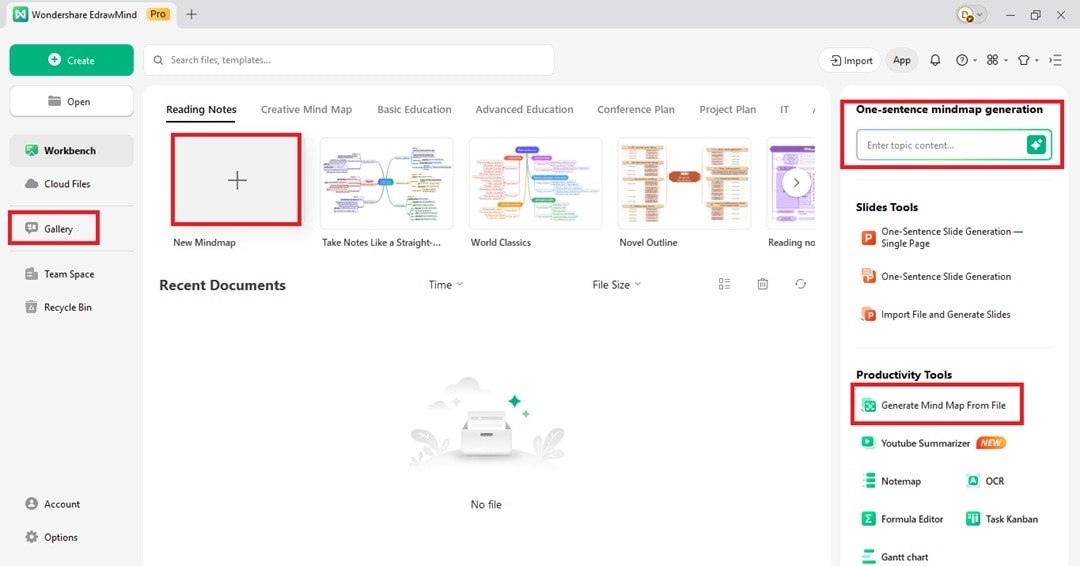
Step 2: Add JetBlue’s Mission and Vision
- Label the Main Idea as JetBlue Mission and Vision Statement Analysis.
- From the center, edit the Main Topic: Mission, Vision, and Core Values.
- Add subtopics for its core components. To do so, select a main topic, then click More from the floating toolbar and select Subtopic.
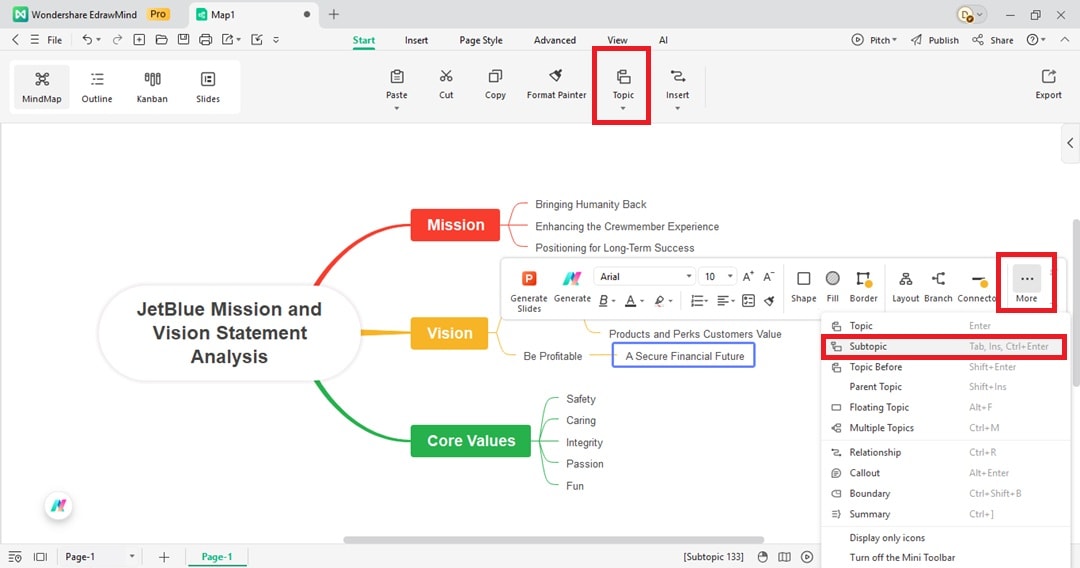
Step 3: Customize and Connect
- Open the right panel and explore the Map tab to adjust themes and styles.
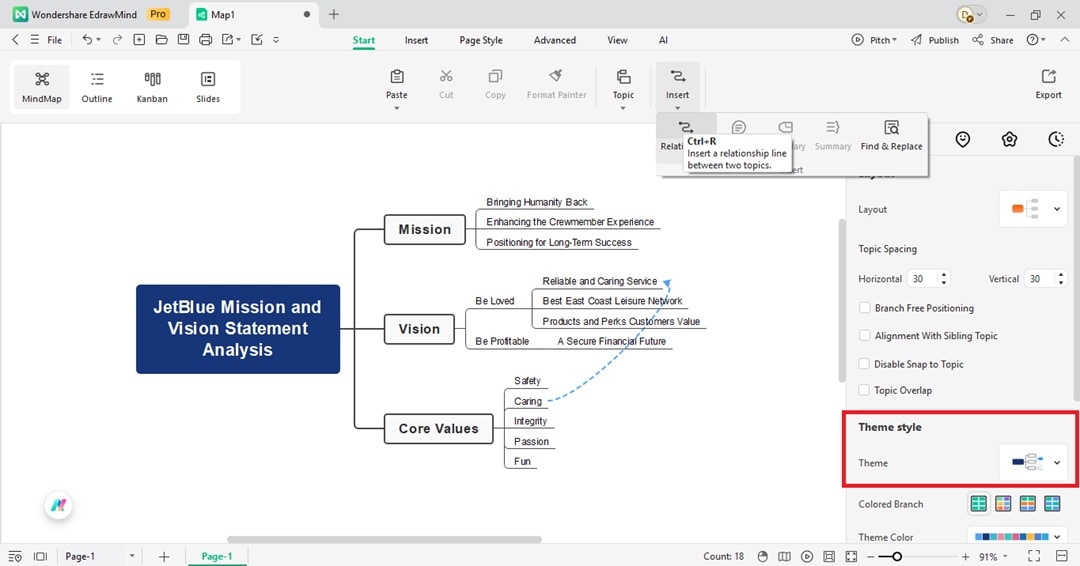
- Save your project and export it in formats like PDF, Word, or image files for reports or presentations.
Tips To Make a Mission and Vision Statement Analysis
A mind map is more than a diagram. It’s your guide to spot patterns and pull insights that matter. Use these tips while shaping your JetBlue analysis.
- Look for Alignment: Check if the mission, vision, and core values fit together. Draw connections in the mind map, such as how caring leads to reliable service.
- Use Evidence: Support claims with proof. Pull from press releases, service updates, or customer feedback to show impact. You can add notes in the mind map if needed.
- Consider the Audience: Investors may care about JetBlue’s financial goals. Travelers want to hear about comfort and reliability.
- Keep it Current: Update your map with fresh moves. JetBlue’s JetForward plan shows how vision evolves.
FAQs
-
What Is Unique About JetBlue?
JetBlue offers the most legroom in coach, free high-speed Wi-Fi, free snacks, drinks, and even live TV. Putting friendly service on top makes the whole experience feel different from other low-cost airlines. -
What Is JetBlue’s Business Strategy?
The airline combines premium perks with affordable prices. Rather than cutting corners, JetBlue focused on cities where its brand has loyal fans. It invests in customer service, drives growth through loyalty programs, and forms partnerships with strategic allies. -
Who Is JetBlue’s Target Audience?
JetBlue’s target audience consists of comfort-seekers not willing to pay beyond their budget. This profile is mainly for young and mid-career professionals who are fascinated by Wi-Fi and legroom. It is also loved by families and leisure travelers who want a friendly and easy trip. JetBlue fuses value and service in a manner that maintains its audience loyalty.




